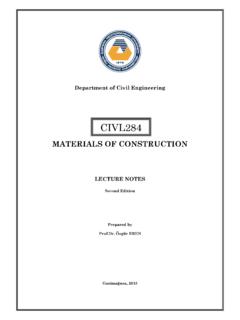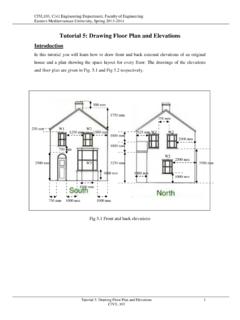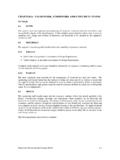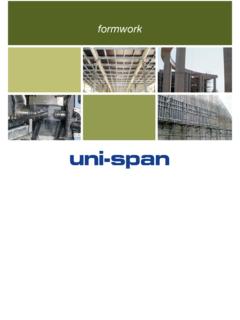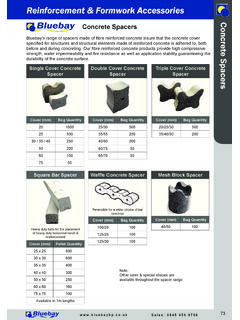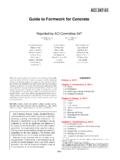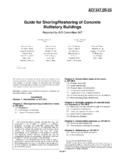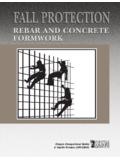Transcription of FORMWORK - Civil Engineering Department - EMU
1 FORMWORK . INTRODUCTION. FORMWORK is a mould or open box, like container into which fresh concrete is poured and compacted. When the concrete is set, the FORMWORK is removed and a solid mass is produced in the shape of the inner face of the FORMWORK . The top of the FORMWORK is normally left open. Falsework is the necessary support system that holds the FORMWORK in the correct position. FORMWORK FOR CONCRETE. STRUCTURES SHOULD BE. 1. Strong enough to resist the pressure or the weight of the fresh concrete plus any constructional live loads. 2. Rigid enough to retain the shape without undue deformation. 3. Economical in terms of the total cost of the forms and the concrete surface finishing when required. 4. Sufficiently watertight to avoid leakage at the joints. FORMWORK ECONOMY. In order to reduce the cost of FORMWORK for concrete structures the following are to be considered: 1. Design the FORMWORK to provide adequate but not excessive strength and rigidity.
2 2. Fabricate the forms into modular sizes to provide more reuses without refabricating when practical. 3. Prepare working drawings prior to fabricating the forms. 4. Prefabricate form sections on the ground rather than on scaffolding. FORMWORK ECONOMY (continued). 5. Use the most economical FORMWORK material considering the initial cost and reuses. 6. Use no more nails than are needed to join the forms together safely. 7. Remove the FORMWORK as soon as it is permissible. 8. Clean and oil forms by using releasing agent after each use. 9. When it is permissible install construction joins to reduce the total quantity of form material required and permit the carpenters to work more continuously. FORMWORK MATERIALS. FORMWORK materials can be classified as: 1. Timber 2. Metals 3. Plastics Timber FORMWORK a. Lumber: Lumber is commonly available material and has excellent strength, weight and cost factor. Lumber is classified as: Boards: 1 to inches thick, 2 or more inches width Dimensions: 2 to 4 inch thick, any width.
3 Timbers: 5 or more inches thickness, 5 or more inches width b. Plywood The use of plywood in concrete forming for form facing has improved the quality of finished concrete. The relatively large sheets of plywood have reduced the cost of building and at the same time have provided smooth surfaces that reduces cost of finishing of concrete surfaces. PIywood is a manufactured wood product consisting a number of veneer sheets, or plies Type of plywood can be grouped as exterior and interior. For FORMWORK the exterior plywood is used. Adhesive used to bond the piles in manufacturing of exterior plywood is watertight and gives maximum number of reuses. Metal FORMWORK 2. Metals The initial cost of metal FORMWORK is more than timber FORMWORK but the umber of reuses of metal FORMWORK is higher than that of timber. in long run metal FORMWORK can be economical. n heavy construction works metal formvvork may require a lifting mechanism to handle the formvvork panels or props.
4 Steel sheet formvvork has the problem of rusting also. To avoid rusting, in every use the surfaces should be oiled with an appropriate releasing agent. in metal formvvork usage, the metal sheets are prepared as panels of standard sizes. This brings the difficulties of erecting irregular dimensions of formvvork. Steel or aluminum or magnesium is the most widely used metals. Plastic FORMWORK 3. Plastics They have impervious surfaces that usually create a smooth f nish to the concrete. Plastic FORMWORK could be reinforced or un- reinforced. Plastic is reinforced by glass fibers. Reinforced plastics are specially produced for a specific formvvork type. Un-reinforced plastics are produced in sheet form with smooth or textured surfaces. Plastic FORMWORK is lighter but less durable than metal formvvork. FORMWORK TYPES (BY SHAPE). Considering shapes, for mvork types can be classified as: Column FORMWORK Beam FORMWORK Slab F6rmwork Wall FORMWORK Column FORMWORK Column FORMWORK Column FORMWORK is made usually with either timber or metal panels.
5 The principle is to create an enclosed box with frames at the exact size of the column and fix it tightly on the kicker left from base or at the last stage of column concreting. The box is held in position by steel column clamps or bolted yokes and supported by timber studs or props Beam FORMWORK Beam FORMWORK Beam FORMWORK consists of open through section and because it is not closed at the top requires more supporting framework to restrain the sides. The supports need to be maintained to the soffit and also provide lateral support to the sides. In timber this is done by the use of a headtree across the top of a vertical member. Metal panels are used with corner pieces, but timber headtrees are needed for vertical support. Slab Floor FORMWORK Slab FORMWORK Floors require a large area of FORMWORK to be provided usually fron beam to beam. Timber floor FORMWORK consists of timber boards or plyvvoo sheets supported on a fra nework and resting on a series of timber joists.
6 Again timber and metal props can be used for vertical supports. Metal panels can be used and bolted or clipped togetherand held in place by a system of metal beams or a tabular scaffold system. Adjustable props need for levelling purposes Wall FORMWORK Wall FORMWORK Wall FORMWORK is a simpler than for other concrete units as the actual forces against it are less, most of the load being carried vertically downwards. The panels at both sides are held in position by ties. Ties are also used as spacer, arranging wall thickness. WaII support systems are usually sloping props at satisfactory intervals. FORMWORK STRIKING TIMES. The time to be allowed before FORMWORK can be removed naturally depends on many factors, such as: type of concrete mix used (type of cement). Rapid hardening cement mix requires less time, whereas high water cement ratio needs longer time for striking the FORMWORK . type of structural member being cast Soffit of beams and slabs or sides of beams or columns require different time.
7 High temperature can cause rapid curing of concrete and FORMWORK can be struck in shorter time than low temperature weather. British Standards FORMWORK Striking Times Minimum Striking Times Structural Member FORMWORK Surface Temperature of Concrete 16 C 7 C 2 C. FORMWORK to columns, 9 hours 12 hours 1 day beam sides and walls FORMWORK to slabs 4 days 7 days 11 days (props left in position). FORMWORK to beam soffit 8 days 14 days 21 days (props left in position). Props to slabs 11 days 14 days 21 days Props to beam soffits 15 days 21 days 30 days Turkish Standard FORMWORK Striking Time Sides of Props of beams Cement beams, Slabs and large Type walls and opening slabs columns forms Normal Portland 3 days 8 days 21 days Cement Rapid hardening 2 days 4 days 8 days Portland Cement FORMWORK TIES. When concrete is placed in wall FORMWORK , the pressure exerted by the fresh concrete tends to force the opposite sides of the FORMWORK apart. Normal economic solution to this problem is to collect the force exerted by the concrete firstly onto the face material, generally plywood, and then to the walling to distribute the force into soldiers on either side of the FORMWORK .
8 The soldiers are prevented from moving apart by use of steel rods called tie rods passing through the concrete to connect the two soldiers together. Tie systems are in two categories: non-recoverable ties and recoverable ties. Non-recoverable ties 1. Snap ties The principal of snap ties is that it is cast into the wall and has normal wedge connection at each and for fixing to the FORMWORK . Once the wall is concreted and the FORMWORK is ready for removal the snap tie is then physically over-stressed and the ends "snap". generally inside the concrete. The snap tie arrangement also acts as a spacer to the FORMWORK so that ordering the right length of snap tie automatically gives the correct wall thickness. Essentially these ties are used in building works on strip and re-erect type of fomwork. 2. Mild Steel Ties Mild steel tie rod systems usually comprise an expendable section of mild steel all thread rod. On each end of the tie rod there is a tapered rubber cone which gives the cover to the expendable tie.
9 After FORMWORK is positioned bolts are used through the FORMWORK into the rubber cone. The system acts as a spacer tie and as with the snap tie the correct length of tie automatically gives the correct wall thickness. The rubber cones are removable after the FORMWORK is struck and the large holes that they make are more easily made good with 2. mortar. 3. Coil Ties The coil tie system is very similar in principle to the mild steel tie. The expendable section of tie comprises two coils of wire. A simple re-useable plastic cone is usually screwed onto the ends of the coil to form a cover to the tie rod after striking. The big advantage of this system is the course rope thread of the tie bolt which screws into the coils, which makes connection much faster than that of the finer. 4. High Tensile Ties The ties rod system comprises a tie rod which is left in the concrete and is connected to a re-useable she-bolt. The big advantage of the tie system is that the entire she-bolt, tie rod and other she- bolt is passed through both faces of FORMWORK after the forms have been erected.
10 Large waler plates are then fitted to the ends of the she-bolts to transfer the high loads into the soldiers or wailings. The she-bolt normally has a taper in the concrete end to allow easy removal once the concrete has gained strength. To prevent the tie rod rotating in the green concrete there is usually either a crimp or a deformation in the rod. The tie system does not act as a spacer to the wall and separate provision needs to be made for obtaining the correct thickness of wall such as a kicker at the base and a spacer at the top of the form. 2. Recoverable Ties After concrete is placed the ties are removed and a hole is left behind of it. It is not good in water reatining structures. Types of recoverable ties are as follows. Ties The bar generally of 15 mm nominal diameter is passed right through the wall and uses an expendable plastic tube with cones at each end as a spacer through the wall. The cone is knocked out from one side of the wall after the formvvork is removed.


